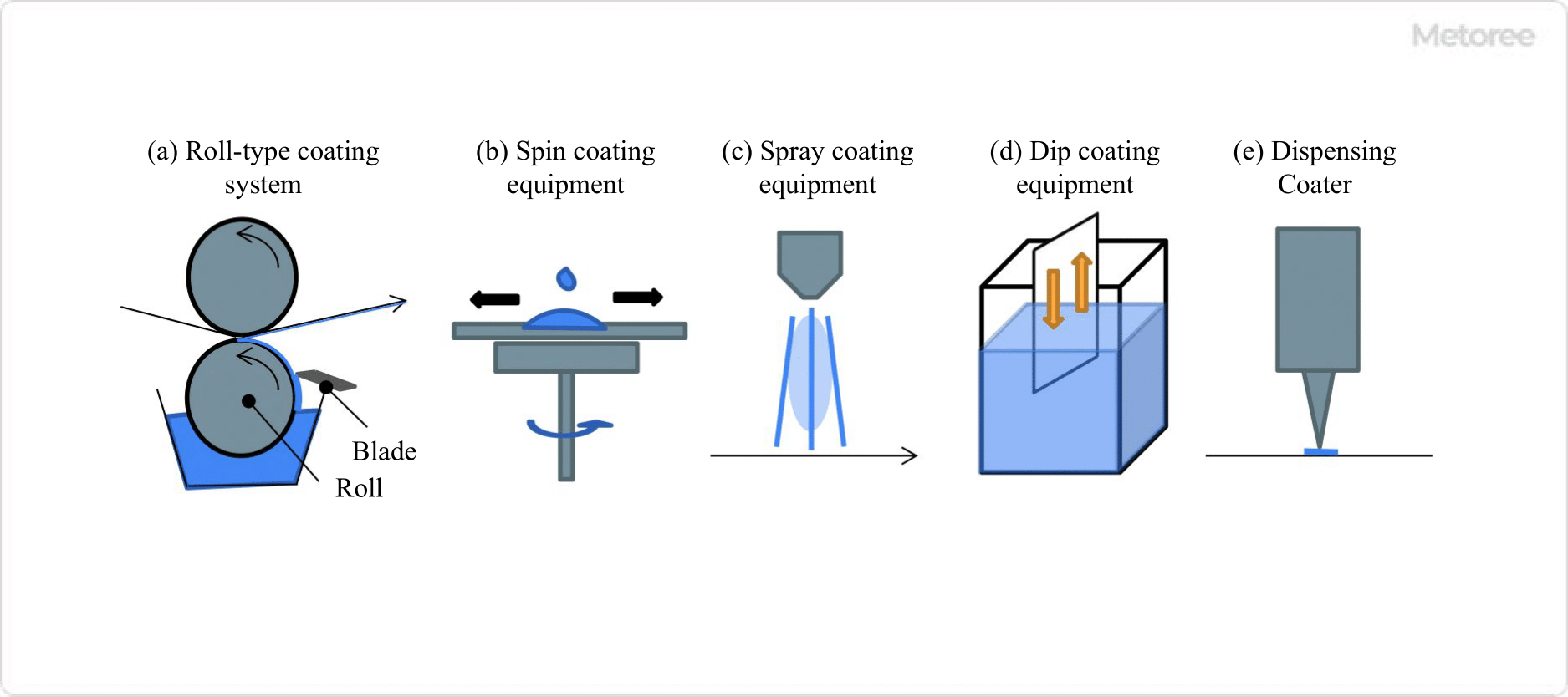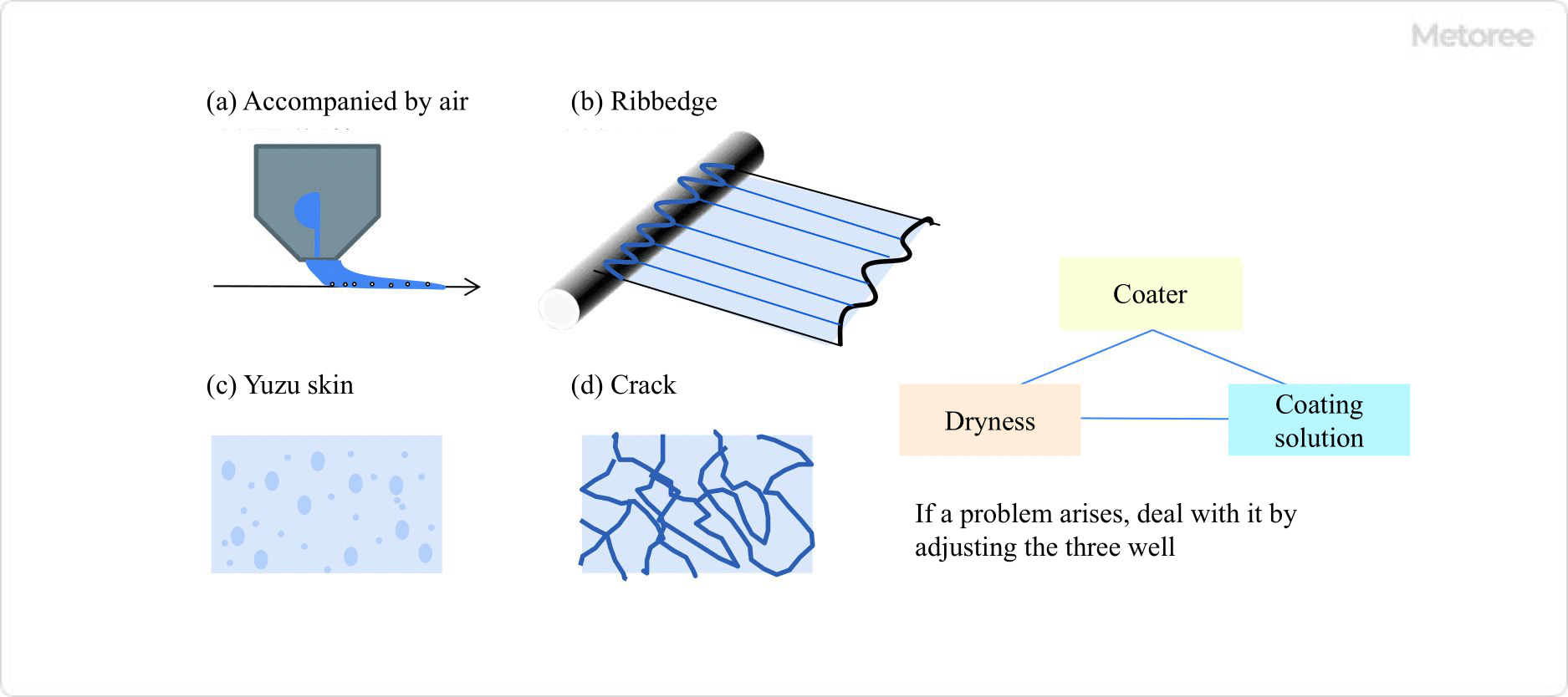What Is Coating Process Equipment?

Figure 1. Types of Coating Equipment
Coating process equipment is used to apply chemicals to products or materials.
Coating process equipment generally uses various coating methods such as roll coaters, spin coaters, dip coaters, spray coaters, and dispense coaters, depending on the shape of the object to be coated, the chemical to be coated, and the purpose of the coating.
In recent years, coating process equipment has evolved dramatically along with improvements in coating technology, as precision coating accuracy is required in industrial fields such as semiconductor manufacturing, flat panel display (FPD) manufacturing, solar cell and rechargeable battery manufacturing.
Uses of Coating Process Equipment
Coating equipment is used to apply coating liquids to objects in a variety of manufacturing processes, such as in the semiconductor field and secondary battery manufacturing. Spin coating process equipment is often used to apply photoresist in the photolithography process in the semiconductor and flat panel display (FPD) manufacturing fields, which require particularly thin, high-performance, high-density devices such as PCs, LCD TVs, smart phones, and tablets.
For functional films and sheet products used in rechargeable batteries, solar cells, automotive parts, housing construction materials, textiles, medical care, etc., roll, spray, and dispense coating process equipment are used to apply chemicals such as sealants, adhesives, and electrode materials.
Principle of Coating Process Equipment

Figure 2. Features of Coating Equipment
Coating process equipment is used to apply materials such as correspondence and chemicals to various production materials. They can be broadly classified into roll, spin, spray, and dispense dispensing systems.
1. Roll Coating Process Equipment
Roll coating process equipment is generally used for coating relatively thin and flat materials such as films and sheets.
Various coating methods are used depending on the nature and viscosity of the chemical to be applied and the film thickness to be applied, such as gravure coaters and reverse coaters that use the rotation of a roller in contact with a liquid reservoir of the chemical to be applied and the winding rotation of the film or sheet material.
Roll-to-roll coating is possible, and this method is most suited for high-speed coating. The characteristic feature of these methods is that a bead is formed between the coating liquid and the object to be coated, and the object to be coated or both the object to be coated and the roll are moved or rotated to apply shear force to the coating liquid and thinly apply it.
Stabilizing this bead is essential for high-quality coating.
2. Spin Coating Process Equipment
Spin coating process equipment is used in the photolithography process in the semiconductor and flat panel display (FPD) manufacturing fields. This is the thinnest coating method.
This is the thinnest coating method, but it is not suitable for mass production because it cannot apply multiple coats and continuous production is not possible.
3. Spray Coating Process Equipment
Spray coating process equipment converts chemicals into fine particles and applies them to automobiles, exterior walls, building materials, and other large objects.
Three types of methods exist for generating granular spray: air, electric, and ultrasonic.
4. Dip Coating Process Equipment
Dip coating process equipment is a method in which the object, regardless of its shape, is dipped into the dip coating solution and pulled up. It can form a uniform thin film and is used for optical lenses, medical systems, electronic devices, and other applications.
Dip coating process equipment is characterized by its ability to form a uniform thin film with minimal loss of coating solution, regardless of the shape of the object.
5. Dispensing Coating Process Equipment
Dispensing coating process equipment is used in situations where relatively precise linear coating is required. This coating process equipment is equipped with a dispensing mechanism that can control the amount of coating, and when even more precise coating is required, a robot is used to provide both accuracy and precision in the amount of coating. Although the dispensing speed is of course inferior, spot dispensing to small areas and coating films of complex shapes can be formed.
Other Information on coating process equipment
Coating Defects and Coating Process Equipment

Figure 3. Lack of Coating and Coating Equipment
No matter how sophisticated the Coating Process Equipment is, a clean coated surface may not be obtained depending on the coating conditions, such as a coating fluid with an incompatible viscosity or coating speed. The types of coating defects and their remedies are as follows.
1. defects caused by coating
| Defect | Cause | Remedy |
| Air entrainment | Occurs when air cannot escape during the application of the coating liquid to the coated object. | Solved by reducing the coating speed. |
| Livestock | This occurs when there is a reverse pressure gradient in the coating section in the direction of the coating. | Solution is to reduce the viscosity of the coating liquid and the coating speed. |
| Strips and holes caused by air bubbles | This is caused by the presence of bubbles in the coating liquid. | Take measures to eliminate bubbles. |
| Uneven horizontal damping | Occurs mainly in reverse gravure coating systems. | Solution is to suppress vibration of the coated object or change the rotational speed of the gravure. |
| Unevenness | Unevenness is caused by the flow of coating liquid in the coating film. | This is solved by improving the coating liquid. |
| Foreign matter | Coating liquid agglomerates or becomes gelatinous. | This can be solved by introducing a filter, etc. |
| Flickering is caused by the high surface tension of the coating solution. | This is caused by the high surface tension of the coating liquid. | Add a surfactant or other agent. |
2. Defects caused by drying
| Defect | Cause | Remedy |
| Yuzuhada (uneven coating surface like yuzu peel) | This defect occurs when the drying speed is too fast. | This defect is caused by drying too fast, and can be corrected by reducing the drying speed or adding a surfactant. |
| Wind ripples | Occurs during hot-air drying. | This is caused by hot-air drying, and can be handled by reducing the speed of the hot-air blow. |
| Cracking | Occurs due to shrinkage of the coating film. | It can be solved by reducing the thickness of the coating. |
Coating is a technology that can be achieved by appropriately selecting Coating Process Equipment, Drying, and Coating Liquid. It is important to select the appropriate Coating Process Equipment, taking into consideration the conditions of the coating liquid to be used and the specifications of the drying oven.